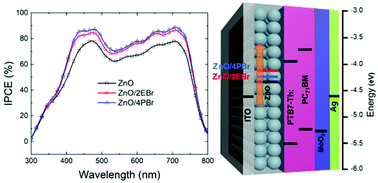Small-molecule electrolytes with different ionic functionalities as a cathode buffer layer for polymer solar cells†
Abstract
In polymer solar cells (PSCs), electrolytes as the cathode interlayer are responsible for generating an interface dipole, which reduces the charge collection barrier at the cathode interface. In this study, small-molecule electrolytes were designed and synthesized as the cathode interlayer in inverted PSCs to overcome high processing costs caused by complicated synthesis procedures. Moreover, the proposed design strategy allows changing the ion size and number of ionic functionalities to tune the magnitude of the interface dipole. The structure of ((benzene-1,2,4,5-tetrayltetrakis(methylene))tetrakis(triphenylphosphonium) bromide) (4PBr) comprises a phenyl core with four benzyl triphenylphosphonium salts and (N,N′-(1,2-phenylenebis(methylene))bis(N,N-diethylethanaminium) bromide) (2EBr) has two benzyl trialkyl ammonium salts. The device based on 4PBr exhibited a power conversion efficiency of 10.63% (Jsc = 20.2 mA cm−2, Voc = 0.79 V, and FF = 66.6%), which is superior to that based on 2EBr (PCE = 9.56%, Jsc = 19.7 mA cm−2, Voc = 0.80 V, and FF = 61.1%). Thus, we demonstrated the possibility of maximizing performances without complicated synthesis procedures.

- This article is part of the themed collection: Celebrating Tobin Marks’ 75th Birthday


 Please wait while we load your content...
Please wait while we load your content...